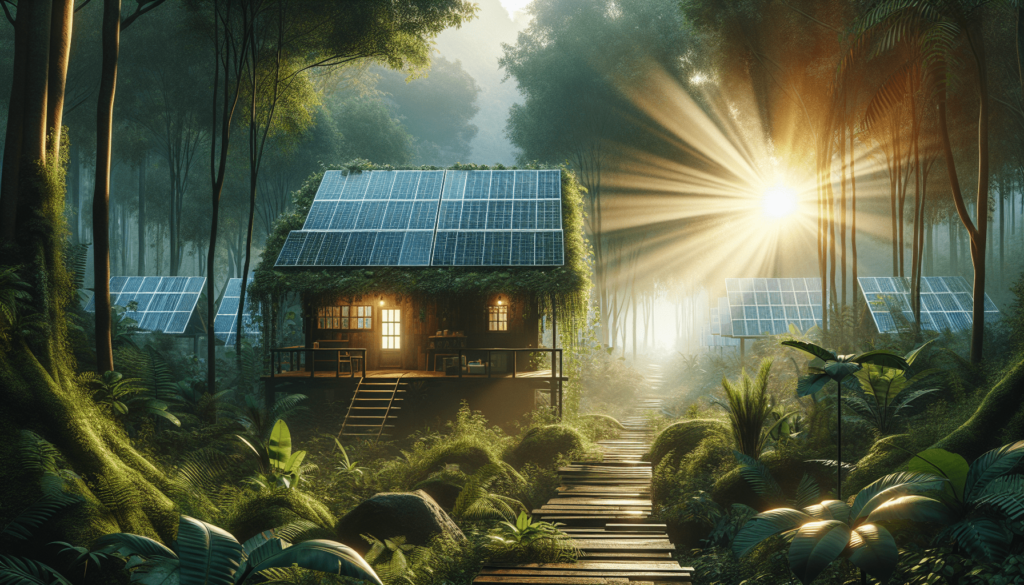
How Many Watts Do You Need To Live Off-grid?
Have you ever wondered how much power you would need to live off-grid comfortably? It’s a question that pops into many minds, especially if you’re considering a more sustainable and independent lifestyle. Living off-grid means getting away from traditional power sources and relying on alternative methods, typically involving solar panels, wind turbines, or other renewable energy sources.

Understanding Your Energy Consumption
Before you can decide how many watts you’ll need, it’s crucial to comprehend your current energy consumption. Your usage can be measured in kilowatt-hours (kWh), which will help you plan your off-grid energy system more accurately.
What is a Kilowatt-Hour?
A kilowatt-hour (kWh) is a measure of energy consumption equal to the amount of energy used by a 1-kilowatt (1,000 watts) device running for one hour. Understanding this unit is fundamental as it’s the standard metric used for household electricity consumption.
How to Determine Your Daily Usage
Determine how many watts you use daily by checking your past electrical bills or using a plug-in energy monitor for your appliances. You can break down your usage into categories like lighting, heating, kitchen appliances, and electronics.
Example Calculation
Let’s say you have three rooms, each needing two 60-watt bulbs for 4 hours a day. The calculation would be:
3 rooms x 2 bulbs/room x 60 watts/bulb x 4 hours/day = 1,440 watt-hours 1,440 watt-hours / 1000 = 1.44 kWh per day
Perform a similar calculation for all your major appliances and note your total daily kWh usage.
Estimating the Total Power Need
Now that you know your daily kWh, let’s estimate your total power needs for living off-grid.
Household Appliances and Their Wattages
List the wattage of your household appliances and their usage hours. This will give you a clear picture of what consumes most of your power.
| Appliance | Typical Wattage | Hours Used per Day | Daily kWh Usage |
|---|---|---|---|
| Refrigerator | 150 | 24 | 3.6 |
| Microwave | 1,200 | 0.5 | 0.6 |
| Laptop | 60 | 8 | 0.48 |
| Television | 100 | 5 | 0.5 |
| Washing Machine | 500 | 1 | 0.5 |
| LED Lighting (8 bulbs) | 60 | 6 | 0.36 |
| Total Daily Usage | 6.04 kWh |
Adjusting For Off-Grid Lifestyle
Living off-grid often means making adjustments to reduce power consumption. This could involve swapping out energy-hungry appliances for more efficient models or changing habits to reduce usage. For instance, you might consider:
- Energy-saving bulbs: Switching to LED lighting can significantly cut down energy usage.
- High-efficiency appliances: Seek out Energy Star-rated appliances.
- Resource management: Be mindful of when and how you use appliances, e.g., only using the washing machine during sunny days if relying heavily on solar power.
After these modifications, your total daily kWh might reduce substantially.
Designing Your Off-grid Power System
Choosing the right power system depends on several factors including your location, budget, and lifestyle preferences.
Solar Power System
Solar panels are the most popular choice due to their decreasing costs and increasing efficiency.
Calculating Solar Requirements
To accurately size your solar power system, consider your location’s sun hours (peak sun hours – the time when the solar power intensity is at least 1,000 watts per square meter).
Here’s a simple formula:
Total Daily kWh / Peak Sun Hours = Solar Panel Capacity Needed
For instance, if you need 6.04 kWh daily and your area receives 5 peak sun hours:
6.04 kWh / 5 hours = 1.21 kW (or 1,210 watts)
To determine the number of solar panels needed:
Total Capacity Needed / Individual Panel Wattage
So, if you choose 300-watt panels:
1210 watts / 300 watts per panel ≈ 4 panels
Wind Power System
Wind turbines can complement solar panels, especially in windy areas.
Determining Wind Power Needs
To size a wind power system, consider your location’s average wind speed and the turbine’s power output at that speed.
The formula is:
Total Daily kWh / 24 hours = Required Average Power Output (in kW)
Suppose you need 6.04 kWh per day:
6.04 kWh / 24 hours = 0.2517 kW (or 251.7 watts)
If you have a wind turbine that generates 500 watts at an average wind speed, it might suffice since it produces approximately:
500 watts x 24 hours = 12 kWh per day
Battery Storage
Reliable power storage ensures you’re covered during periods without sun or wind. Batteries store excess energy which you can use at night or during cloudy days.
Battery Capacity Calculation
You need to calculate the necessary battery storage to sustain your household during no-sun or low-wind days. Typically, assume a 3-day autonomy.
Formula:
Total Daily kWh * Days of Autonomy = Required Battery Storage (in kWh)
For 3 days:
6.04 kWh/day x 3 days = 18.12 kWh
Convert this into amp-hours (Ah) for easier planning:
18.12 kWh / 48V (standard battery voltage) = 377.5 Ah
Inverters
Inverters are necessary to convert the DC power generated by solar panels and wind turbines into AC power used by most household appliances.
Inverter Sizing
The inverter should handle the peak watts of your combined appliances. Add up the highest simultaneous loads:
Example:
- Refrigerator: 150 watts
- Microwave: 1200 watts
- TV: 100 watts
Total:
150 + 1200 + 100 = 1,450 watts
Choose an inverter rated slightly higher, around 2,000 watts, for a safety margin.
Configuring and Installing Your System
Once you have all components sized, the next step is setting them up.
Solar Panel Installation
Opt for a south-facing direction in the Northern Hemisphere or north-facing in the Southern Hemisphere for maximum sun exposure. Panels should be at an angle equal to your latitude for optimal sun capture.
Mounting Wind Turbines
Install turbines well above any obstructions to capture steady wind. Generally, a height of 30 feet above any surrounding structures is recommended.
Battery Bank Setup
Place your battery bank in a well-ventilated, temperature-controlled area to maximize efficiency and lifespan. Ensure batteries are properly connected and labeled for easy maintenance.
Connecting the Inverter
Place the inverter near the battery bank to reduce energy loss. Ensure all connections are secure and follow the manufacturer’s wiring guidelines.

Maintenance and Monitoring
An off-grid system requires regular upkeep to function optimally.
Solar Panels
Clean panels every few months to remove dust and debris. Check for any damage or shading issues that might reduce efficiency.
Wind Turbines
Inspect turbines for wear and damage. Ensure that the blades are free from obstructions and the mounting is secure.
Batteries
Regularly check battery connections for corrosion and ensure they hold a charge efficiently. Test battery voltage and specific gravity (for lead-acid batteries) monthly.
Inverter
Keep the inverter in a cool, dry place. Periodically check for efficient operation. Ensure the cooling system is working as overheating can damage the inverter.
Planning for Seasonal Variations
Adjust your energy expectations and system usage based on seasonal changes.
Winter Considerations
Shorter days and lower sun angles can reduce solar efficiency in winter. Increase reliance on stored energy and consider supplementary sources like a generator.
Summer Adjustments
Longer days and higher sun intensity will boost solar panel output, providing an opportunity to use more energy-hungry appliances or generate extra power to store for later.
Sustainable Living Practices
Adopting energy-efficient practices maximizes the effectiveness of your off-grid system.
Efficient Appliances
Always choose appliances with high energy efficiency ratings. This not only reduces energy consumption but also extends the lifespan of your off-grid system.
Energy-Conscious Habits
Turn off lights and appliances when not in use. Unplug devices that consume standby power, and use natural light and ventilation whenever possible.
Water Heating Solutions
Consider solar water heaters or on-demand gas water heaters in place of standard electric models. These alternatives significantly cut down on your energy expenditures.
Final Thoughts
Creating a comfortable off-grid living experience is entirely possible with careful planning and the right equipment. By understanding your energy needs, tailoring your system to fit those needs, and adopting sustainable habits, you can enjoy an independent lifestyle while minimizing your environmental impact. Remember, the path to effective off-grid living is a journey of continuous learning and adjustment. Stay informed and be prepared to adapt your system as your needs and circumstances evolve, ensuring a reliable and enjoyable off-grid experience.
